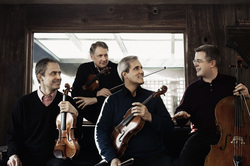 The Emerson String Quartet.
The Emerson String Quartet. The seriousness of the event was underscored by the opening work, Beethoven’s Op. 95 F Minor Quartet, the “Serioso.” From the opening movement, the Emersons made this work into a high-drama narrative – unsettled, and full of “hairpin” dynamics. The second movement featured a more expansive approach to phrasing, and the third was marked by robust outbursts or energy. In the finale, the Emersons returned to the dark, unsettled ebb-and-flow of the opening movement, ending with a splash of sunny warmth.
Benjamin Britten’s Quartet No. 2 is a tough nut for any quartet (or audience) to crack. The Emersons took a dispassionate approach to the sphinx-like opening movement, displaying the piece as a stark, opaque mystery. The second movement was more satisfying – taut and full of tension. The expansive final movement seemed to offer many frustrated hopes for closure before it finally ended (this was Britten’s fault, not the Emersons). However, the movement’s cello solo was a shining moment for cellist Paul Watkins, the newest member of the quartet, who joined the ESQ about a year ago.
To conclude the concert, the Emersons chose a crowd-pleaser, Schubert’s “Death and the Maiden.” This was the highlight of the evening, with the Emersons embracing both the style and the substance of every note. The opening movement was all about thematic contrast, alternately sweet and dark. In the second movement, the ESQ’s playing ran the gamut, form touching simplicity to hammer-and-tongs intensity. Cleverly emphasized syncopations enlivened the third movement, and the finale was edgy and brilliant. In all movements, a fluid interplay of foreground and background ideas gave the performance a sophisticated polish.
The encore – the “Cantabile” movement from Haydn’s Op. 35 No. 5 – was a charming touch.
© Colin Eatock 2014
 RSS Feed
RSS Feed

